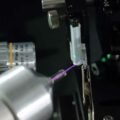Researchers have transmitted melodies from lucid dreams into waking reality in a recent study that fuses neuroscience, technology, and the arts.
Utilizing advanced electromyography (EMG) sensors, the researchers say results reaffirm the untapped creative potential lying dormant in our subconscious minds, particularly in the realm of music.
The research, published in the scientific journal Dreaming, hails from REMspace, a California-based startup led by Michael Raduga. The study offers new perspectives on lucid dreaming—a mental state in which individuals know they are dreaming and can exercise some level of control over the dream’s events.
The term “lucid dreaming” was coined by Dutch psychiatrist Frederik Van Eeden in his 1913 article A Study of Dreams.
“In these lucid dreams, the reintegration of the psychic functions is so complete that the sleeper remembers day life and his own condition, reaches a state of perfect awareness, and is able to direct his attention and to attempt different acts of free volition. Yet the sleep, as I am able confidently to state, is undisturbed, deep, and refreshing,” Van Eden wrote.
The existence of lucid dreaming dates much further, with Greek philosopher and polymath Aristotle making one of the earliest recorded references to the phenomenon in the 3rd century B.C., writing, “Often when one is asleep, there is something in consciousness which declares that what then presents itself is but a dream.”
Throughout the 20th and 21st centuries, lucid dreaming has been substantiated in numerous scientific studies, including research into how it may be used in sleep therapy.
Just recently, research published in Psychology of Consciousness: Theory, Research, and Practice found that lucid dreaming showed positive associations with subjective sleep quality, mental well-being, and a reduced sense of loneliness.
Beyond validating the existence of lucid dreaming, modern neuroscience has also delved into the brain’s active regions during these dreams. According to a study published in Sleep, increased activity is observed in the prefrontal cortex, precuneus, occipitotemporal cortex, cuneus, and parietal lobules during lucid dreams.
Research has also linked higher gray matter volume in the anterior prefrontal cortex and better connectivity between brain regions to the ability to experience lucid dreams.
What sets this recent study apart is its focus on the musical dimensions of lucid dreaming.
Speaking with PsyPost, the lead study author and CEO of REMspace, Michael Raduga, explained the personal motivations that led to this recent research.
“Once, when I was a teenager, I entered a lucid dream and heard the best ever single of the Rammstein band (I was their fan),” Raduga explained. “It had extremely high quality and definitely was their best song. The problem was that it did not exist in reality, and I knew it. That case demonstrated to me the true power of our brain. Since then, I always wondered how to transfer lucid dream melodies into reality.”
In the study, researchers wanted to see if dreamers could intentionally generate specific EMG signals through muscle contractions to produce musical melodies while asleep.
While awake, study participants, experienced in lucid dreaming, were taught how to play a simplified version of the intro to “We Will Rock You” by Queen using their arm muscles. When entering a lucid dream state, the participants were directed to generate the melody using the same muscle movements.
During experiments, participants wore EEG, EOG (electrooculography), and EMG sensors, which allowed researchers to monitor sleep stages and confirm when one was experiencing a state of lucid dreaming.
Out of seven confirmed instances of lucid dreaming, six participants successfully played the melody in their dreams. Of the attempts, in three cases, EMG sensors could detect electrical spikes in volunteers’ arm muscles, allowing for the real-time transfer of the musical rhythms from the dream world.
“The results prove the concept that people can transfer rhythmical EMG impulses from L.D., which could be potentially useful for transferring sounds or music from L.D. into reality,” wrote researchers.
Raduga sees endless possibilities in this recent discovery. “In reality, there aren’t significant limitations on melody complexity. It’s just a matter of time when technologies like this will be widespread because there is nothing very difficult in them,” Raduga explained. “The only problem is that you need to know how to induce lucid dreams.”
A 2018 study published in The British Journal of Psychiatry found that dream content could be influenced by offering meaningful verbal stimuli to a person who is experiencing lucid dreaming.
Additionally, in experiments published in 2021 in Current Biology, scientists from the U.S., France, Germany, and the Netherlands found that one can engage in real-time dialogue with another awake person while experiencing lucid dreaming.
These results, coupled with this recent discovery, suggest that shared lucid dreaming environments could enable collaborative artistic and musical creation as technology advances.
The researchers from REMspace believe that the results of their recent study demonstrate that the subconscious mind is a treasure trove of untapped creative potential.
“I’m sure that any human has ingenious potential. It is hidden in our subconsciousness,” says Raduga. “The best way to control it is to induce lucid dreams.”
Tim McMillan is a retired law enforcement executive, investigative reporter and co-founder of The Debrief. His writing typically focuses on defense, national security, the Intelligence Community and topics related to psychology. You can follow Tim on Twitter: @LtTimMcMillan. Tim can be reached by email: tim@thedebrief.org or through encrypted email: LtTimMcMillan@protonmail.com

